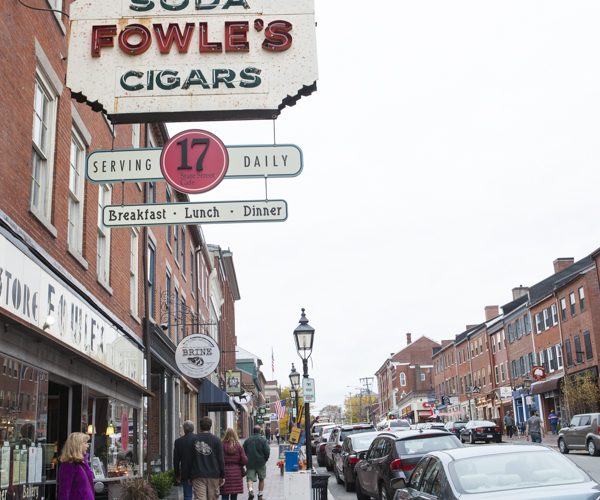Perhaps it’s the striking scenery, overlooking the vista where the Merrimack River empties into the Atlantic Ocean. Or maybe it is the city’s international identity as a shipbuilding destination. Or the craftspeople who once worked for Towle Silver Manufacturing or at the renowned decorative comb factory. Whatever the reason, Newburyport has been a magnet for creative types for centuries, says local historian and author Ghlee Woodworth, noting that a young John Quincy Adams likely attended concerts and poetry readings while studying law in Newburyport in the 1780s, when many grand salons in the Port City’s mansions were said to rival those anywhere in the world. Just this year, as further evidence of the city’s ties to the performing arts, a tiny theatre was discovered during a renovation of a downtown historical house.
“Newburyport has always been very culturally oriented,” Woodworth says. “Even shipbuilding is an art.”
So it’s no wonder that when it came to choosing the borders for the city’s new cultural district, it was hard to know where to draw the line. In fact, when the committee first presented the parameters for the new district to the state for approval, they were told it was too big, says Lois Honegger, Newburyport’s administrator for arts, tourism, and cultural affairs.
“We have so many partners outside the district,” Honegger says, gesturing to the map a bit ruefully. “We didn’t want to leave anyone out.” But there was no way to contain all 13 art galleries, four museums, four theatres, and 12 performance spaces within the walking distance required by the state. Indeed, the cultural destinations in the city reach far outside of downtown, all the way to Maudslay State Park, a 480-acre estate overlooking the Merrimack that hosts numerous annual theatre and music performances and even an outdoor sculpture show.
“The arts have strong roots and a long history in Newburyport and have drawn a range of artists, actors, musicians, and dancers to live and work here,” says Newburyport Mayor Donna Holaday. “Interest in the arts continues to grow as more and more festivals and events are held to honor and support the amazing talent in the city.”
From the springtime literary festival to the chamber music festival to a documentary film festival, not to mention the granddaddy of Newburyport festivals, Yankee Homecoming—a celebration that attracts thousands of visitors each year—the city takes every opportunity to trumpet and celebrate its offerings—something that has not gone unnoticed by tourists.
That attention has only increased since the state’s recognition of the Newburyport Cultural District, one of 29 in Massachusetts, Honegger says, adding that in the year since the designation, tourism numbers have increased 10 percent, with another three percent gain expected this year.
“We are starting to entice Germans, Chinese, Italians, Australians, and Brits,” Honegger says, noting that additional increases in tourism—a natural stopping point for visitors exploring the coastline—are hindered by the lack of a hotel.
Some may be drawn by the culture, and others perhaps by the history and the connection to the sea that comes with being an official Coast Guard City. But everyone who visits will find something great to eat. Newburyport is quickly gaining a reputation for its innovative food scene, with two craft breweries, an embarrassment of delectable baked goods, several gourmet food shops, and 54 restaurants serving everything from cutting-edge cuisine to traditional New England fare and gourmet pizza.
“It has been very interesting and exciting over the past decade or so to watch the significant expansion of restaurants in our city,” says Mayor Holaday. “The competition is clearly supporting the growth of the sector and drawing more residents and visitors to a range of places to dine in our downtown and other areas.”
To celebrate the diversity in eating options, the city, in collaboration with the Newburyport Chamber of Commerce and Industry, debuted Savor Newburyport this past fall, a weeklong celebration partnering downtown shops, dining establishments, and even local fitness studios for a series of special events.
The name “Savor” was meant to embrace all the city has to offer, says Ann Ormond, president of the chamber. “Whether you savor the water or the scene or the food, we have a nice package,” Ormond says. “Many downtowns are missing a part of that package.”
Downtown Newburyport was almost missing a big part of the package—historic charm. “We were one signature away from losing downtown,” notes historian Woodworth, explaining how in the 1960s, urban renewal funding favored tearing down old buildings. Then-mayor George Lawler, urged on by a group of concerned citizens, refused to sign the paper that would have led to mass demolition to create parking lots and strip malls, she says.
These days, as the community tussles with growth and success and how best to serve everyone while addressing those needs, preservation is top-of-mind, says Mayor Holaday.
“First and foremost, our community strongly recognizes the significance of the urban renewal… effort [was made] that resulted in preserving rather than bulldozing our downtown,” Holaday notes, adding that throughout the city’s core, zoning protections for the historic buildings are in place, all sidewalks must be brick, and even signage is carefully regulated.
Thanks to the foresight of those concerned citizens and ongoing preservation efforts, the city is well known for its unusually rich stock of early architectural styles. From First Period and Georgian to Federal and Greek Revival, a stroll along High Street reveals them all.
Some say that new ideas require old buildings—such may be the case in Newburyport, which is often cited as an example of urban renewal done right. Today’s award-winning chefs, musicians and artists, families, and residents all benefit from the echoes of history and the solid brick architecture that signify this vibrant city.

